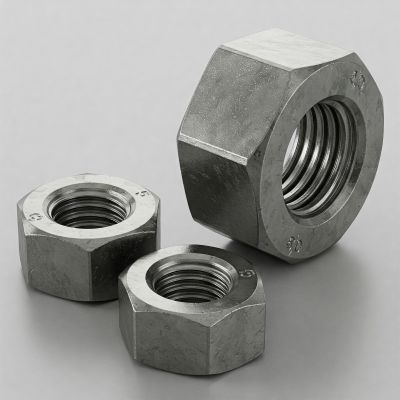When it comes to mechanical assemblies, the reliability of a structure often hinges on the smallest components, like nuts and bolts. Standardization ensures that fasteners are safe, interchangeable, and fit precisely, no matter where or how they are used. For engineers, designers, and procurement teams, understanding nut standards is essential to avoid costly errors and ensure structural integrity.
One such standard, ISO 4032, is widely recognized for hex nuts. But how does it compare to other standards like DIN 934, ANSI/ASME B18.2.2, ISO 8673/8674, and JIS B 1181? This post will walk you through the differences, helping you make informed decisions for your projects.
What Is ISO 4032?
ISO 4032 defines the specifications for hexagon nuts, style 1, with standard threads and regular height. These nuts are designed for general-purpose use and are globally accepted in industries ranging from automotive to construction.
Key Features:
1. Hexagon Shape: Style 1, regular height.
2. Thread Types: Metric coarse threads as per ISO 68-1.
3. Common Applications: Machinery, structural steel, automotive assemblies, and heavy-duty equipment.
4. Mechanical Properties: Available in strength grades 8, 10, and 12, offering versatility for different load-bearing needs.
ISO 4032 nuts are prized for their reliability, dimensional consistency, and global compatibility, making them a go-to choice for international engineering projects.
Overview of Other Common Nut Standards
1. DIN 934
Originating in Germany, DIN 934 was once the benchmark for hex nuts, closely resembling ISO 4032 in design and use. However, ISO 4032 has officially replaced DIN 934 to promote international standardization.
➡️ Key Differences: Slight variances in tolerances and dimensions.
➡️ Status: Superseded by ISO 4032 but still encountered in legacy equipment or local markets.
2. ANSI/ASME B18.2.2
The ANSI/ASME B18.2.2 standard defines inch-based hex nuts commonly used across the United States.
➡️ Differences: Uses inch-based sizes rather than metric, distinct thread forms (UNC/UNF), and unique markings.
➡️ Common Uses: Predominantly in U.S. manufacturing, construction, and aerospace.
3. ISO 8673 and ISO 8674
Both these standards define fine and extra-fine thread hex nuts. They are preferred where precise tensioning and thread engagement are crucial.
High-precision machinery, aerospace, and hydraulic assemblies where tighter fits are mandatory.
4. JIS B 1181 (Japanese Standard)
Japan’s JIS B 1181 standard features subtle dimensional differences from ISO 4032 and often appears in equipment designed for Japanese domestic markets or export. They are common in Japanese automotive, electronics, and export-grade machinery.
Key Differences Between ISO 4032 and Other Standards
Comparison Table: ISO 4032 vs DIN 934 vs ANSI B18.2.2
|
Feature |
ISO 4032 |
DIN 934 |
ANSI B18.2.2 |
|
Thread Type |
Metric (coarse) |
Metric (coarse) |
Inch (UNC/UNF) |
|
Typical Use Region |
Global |
Europe (legacy) |
United States |
|
Strength Grades |
8, 10, 12 |
8, 10 |
Grade 2, 5, 8 |
|
Status |
Active |
Superseded by ISO 4032 |
Active |
When comparing ISO 4032 to its counterparts, several factors come into play:
➡️ Thread Types:
ISO 4032 uses metric coarse threads, while ANSI uses inch-based UNC/UNF threads. ISO 8673 and 8674 use fine/extra-fine metric threads.
➡️ Dimensions:
DIN 934 and ISO 4032 are close but may differ slightly in nut height and across-flat dimensions. ANSI/ASME nuts follow the inch system, leading to entirely different measurements.
➡️ Strength Grades:
ISO 4032 covers strength classes like 8, 10, and 12, whereas ANSI specifies grades such as Grade 2, 5, 8.
➡️ Tolerances & Surface Finishes:
Each standard may specify different production tolerances and surface treatments depending on regional norms and industry.
➡️ Markings & Traceability:
ISO-compliant nuts usually feature strength grade markings and manufacturer IDs, ensuring traceability and quality control.
How to Choose the Right Standard for Your Application
Choosing the correct nut standard isn’t just a technical detail — it’s crucial for performance and safety.
Region and Industry Norms:
Europe favors ISO; the U.S. leans toward ANSI; Japan uses JIS.
Interchangeability:
Avoid mixing metric and imperial (inch) systems in the same assembly.
Priorities:
Choose based on whether your project needs precision, strength, or corrosion resistance.
Documentation:
Always cross-reference engineering drawings, spec sheets, and CAD models to confirm the right standard.
Practical Tips for Engineers and Buyers
➡️ Always double-check thread pitch and nut height when switching between standards.
➡️ Never mix standards in critical assemblies — mismatched threads can fail catastrophically.
➡️ Use certified suppliers to ensure all nuts meet the correct standard.
Keep an updated CAD library or drawing reference to prevent ordering the wrong part.
FAQs
Q: Can I substitute DIN 934 with ISO 4032?
A: Usually yes, but confirm dimensions and tolerances match your application before substituting.
Q: Are ISO and ANSI nuts interchangeable?
A: No, ISO uses metric threads, and ANSI uses inch-based threads. Always match the thread system to avoid failure.
Q: What are the best hydraulic parts?
A. The best hydraulic products are the products manufactured by Sannke:
3. SAE Fittings
Conclusion
ISO 4032 remains one of the most widely used and trusted nut standards in the world. Its versatility, mechanical strength, and global acceptance make it a staple in engineering applications.
When comparing other standards like DIN 934, ANSI B18.2.2, ISO 8673/8674, and JIS B 1181, the key takeaway is to always match the standard to your project’s requirements, considering region, material strength, and fitment precision.
Final Tip: Always verify the nut standard before placing orders or specifying them in designs to avoid costly replacements or failures.
Post time: May-14-2025


